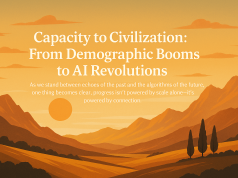In the pulsating veins of the global economy runs the blood of a diverse workforce, a reflection of our world’s intricate tapestry of cultures, ages, and ideologies. As we stand at the crossroads of change, the global workforce is undergoing a seismic shift, shaping the future of businesses and forcing leaders to recalibrate their strategies for recruitment, retention, and management.
The contemporary workplace is a melting pot of generations from Baby Boomers to Gen Z, each bringing unique values, work ethics, and expectations. Amid this generational dance, culture adds its own rhythm, introducing varied perspectives that can both challenge and enrich a company’s dynamics. The question now for organizations, especially those read by The New York Times’ erudite audience, is not whether diversity should be embraced but how we can harness its potential to fuel innovation and growth.
Diversity is not just a moral imperative but a business one. Studies have repeatedly shown that companies with more diverse workforces perform better financially. They are 35% more likely to have financial returns above their respective national industry medians. This is not mere coincidence; diverse teams are more creative, they are better at problem-solving, and they understand a wider array of customers.
As we delve into the practices of companies adapting to the changing tides, it’s clear that a strategic approach is paramount. Leaders who create an inclusive culture are setting their businesses up for success. This means not only hiring a diverse workforce but fostering an environment where everyone can thrive. Active mentorship programs, flexible work arrangements, and continuous education on cultural competence are becoming the norm.
However, this journey is not without its challenges. Language barriers, cultural misunderstandings, and unconscious bias are just a few of the hurdles to overcome. The role of technology in facilitating diversity cannot be overstated. From AI in recruitment that helps reduce bias to collaborative platforms that connect global teams, technology is the great enabler in this new age of work.
Yet, we must not forget the human element. Beyond the numbers and the tech solutions lie real people with aspirations and potential. The ethical imperatives for inclusivity in the workplace demand empathy, respect, and a commitment to equity. When companies embrace these values, the business outcomes are measurable – increased employee engagement, higher retention rates, and a reputation as an employer of choice.
The immigration policies of nations also play a significant role in shaping the workforce. They determine who has access to opportunities and who is left out. Companies at the forefront are advocating for policies that allow them to tap into the global talent pool, recognizing that immigration can be a source of innovation and competitive advantage.
What does this mean for your organization? The shift to a truly global, diverse workforce calls for introspection and action. Assess your company’s current diversity and inclusion initiatives. Do they align with the values of a readership that champions progressiveness, equality, and thought leadership? Consider actionable steps—could you build cross-cultural communication training, or establish diversity task forces that reflect the spectrum of your workforce?
In conclusion, embracing diversity is not just about social justice; it’s about business survival in an increasingly complex and interconnected world. As The New York Times’ readers would appreciate, it’s about leveraging the full spectrum of human talent to create a more dynamic, innovative, and ultimately successful business. Let your company be at the forefront of this power shift, embracing the future of work with open arms and an open heart.




























